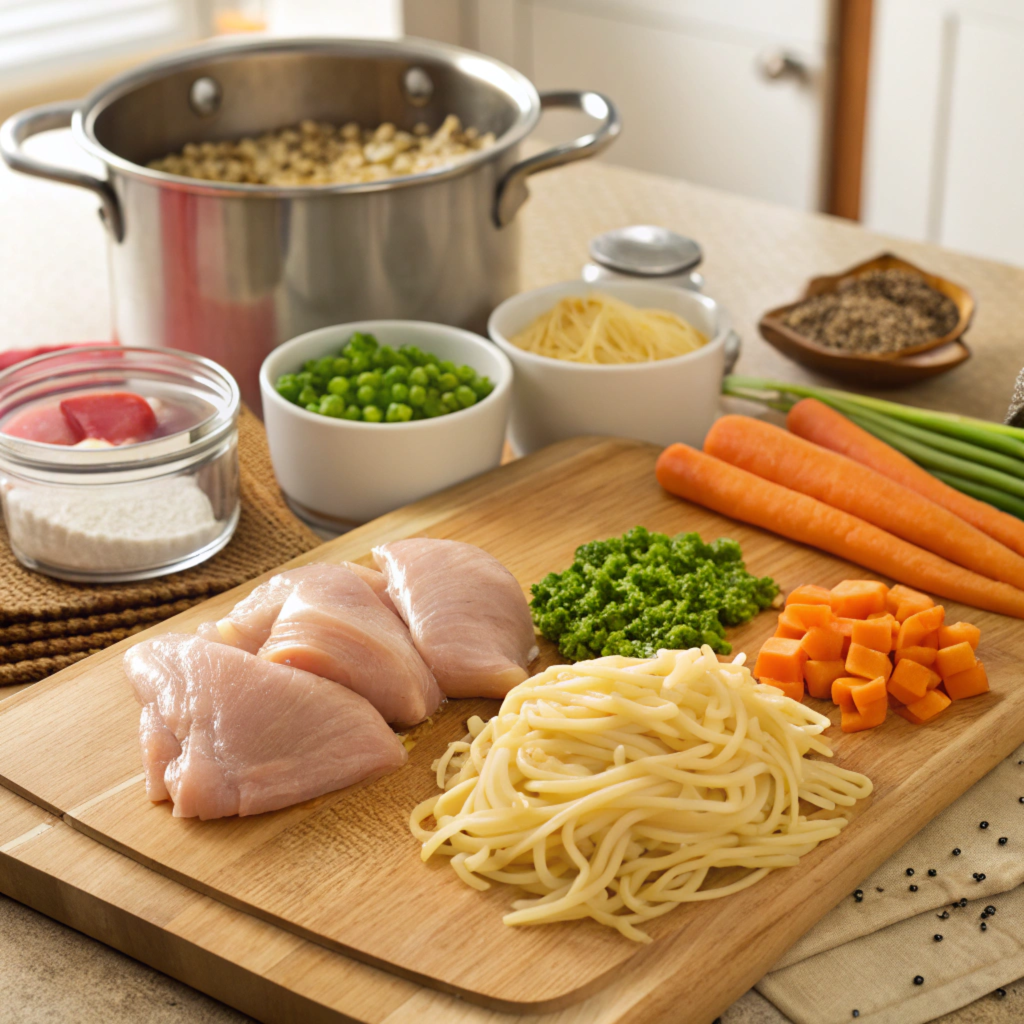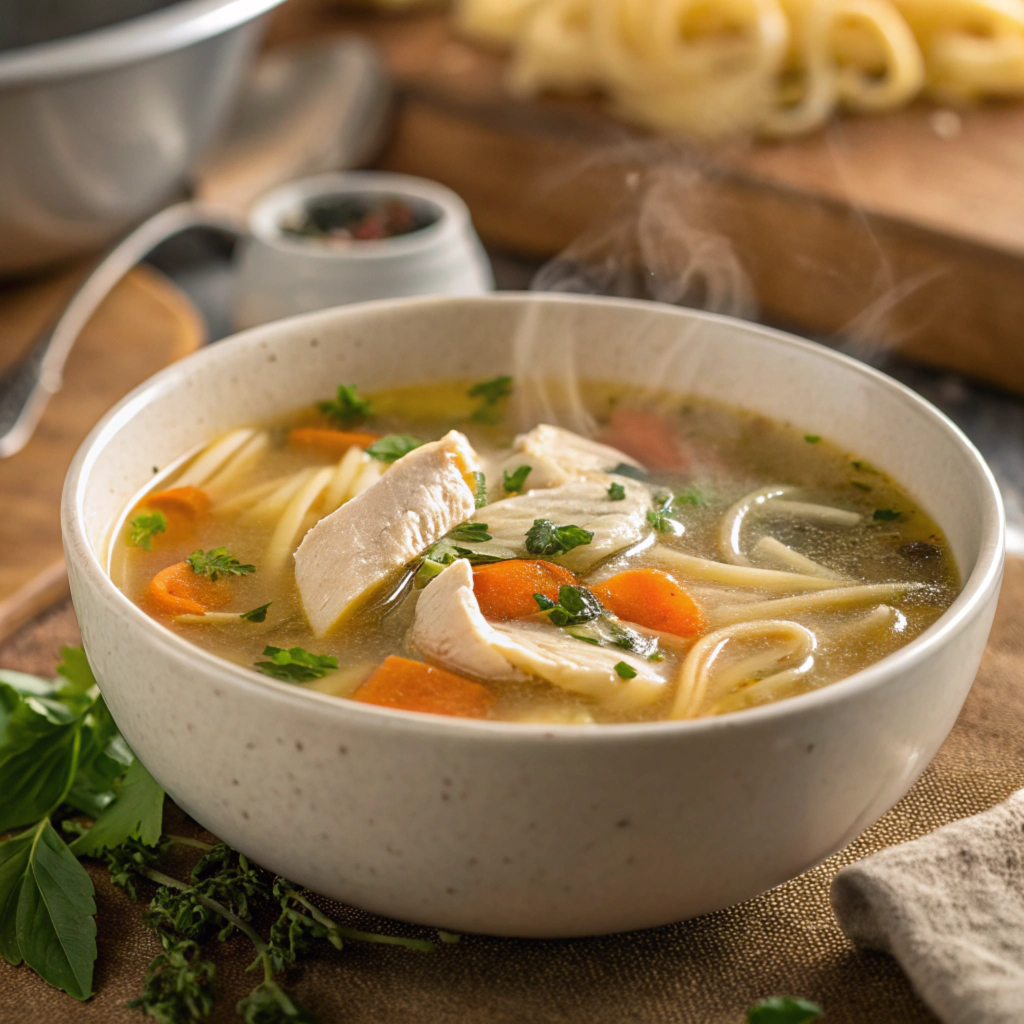
Why Campbell’s Soups Are Popular
Campbell’s soups have long been a staple in countless households. From their comforting flavors to the nostalgia they evoke, these soups have become synonymous with quick and easy meals. But have you ever wondered exactly what goes into your favorite varieties? Learning about the ingredients in Campbell’s Creamy Chicken Noodle Soup can offer deeper insight into why it remains a beloved pantry staple. Understanding its components, from chicken and noodles to creamy dairy elements and seasonings, helps you make more informed dietary choices.
Beyond nostalgia, the brand’s popularity stems from its extensive variety. Shoppers know they can find a soup to satisfy their palate, whether they crave a classic broth-based option or something rich and indulgent. By taking a closer look at the ingredients, you can determine whether this creamy chicken noodle option aligns with your preferences and needs.
The Appeal of Creamy Chicken Noodle Soup
While Campbell’s Chicken Noodle Soup remains iconic, its creamy chicken noodle variant holds a special place for those seeking extra richness. Traditional chicken noodle soup is light and clear, with tender noodles and shredded chicken in a savory broth. The creamy version takes this foundation and enhances it with a velvety dairy component. As a result, the soup feels more indulgent and hearty, akin to a comforting home-cooked meal in a can.
This creaminess not only adds body but also melds the flavors seamlessly. By examining the ingredients in Campbell’s Creamy Chicken Noodle Soup, you can gain insight into what makes it so enjoyable. The result is a comforting dish with balanced savory notes, subtle sweetness from the vegetables, and a luscious mouthfeel due to the dairy. It can function as a standalone meal, a hearty snack, or a quick fix when time is short.
Importance of Knowing Soup Ingredients
Understanding what’s inside your favorite soup helps you make informed dietary choices. Not everyone adheres to the same nutritional guidelines, and some must consider allergens, sodium intake, or the presence of artificial additives. Becoming familiar with the ingredients in Campbell’s Creamy Chicken Noodle Soup allows you to determine if it aligns with your health and wellness goals.
This awareness also lets you decide if the soup fits into your personal definition of a balanced meal. You might choose to enjoy it as an occasional treat or incorporate it into a meal plan with fresh vegetables and lean protein. In any case, knowing the details ensures you’re making choices that serve your body and lifestyle.
Core Ingredients Breakdown
Protein Source
Chicken Meat: White and Dark Meat Pieces
Chicken provides the protein backbone of this creamy soup. Manufacturers include both white and dark meat, typically sourced from the breast and thigh portions. This blend offers a nuanced flavor profile: white meat delivers a lean, mild taste, while dark meat contributes a richer, more savory depth. Together, these cuts create a balance, ensuring each spoonful contains tender, flavorful chicken.
Producers often cook the chicken before canning, allowing it to retain moisture and flavor. This preparation ensures that when you heat the soup, the chicken remains juicy and satisfying, rather than overcooked or dry.
Chicken Broth: Provides a Rich, Savory Base
Chicken broth underpins the entire flavor experience. Usually made from simmering chicken bones and meat with aromatics, broth infuses the soup with savory depth. Although Campbell’s may use a concentrated or reconstituted form, it still provides that comforting chicken essence. This base ensures the product tastes distinctly like a classic chicken noodle soup, even with added creaminess.
Think of the broth as the cornerstone that ties everything together. It merges the richness of the cream with the wheatiness of the noodles and the natural sweetness of the vegetables, resulting in a cohesive, comforting dish.
Noodles and Pasta
Enriched Egg Noodles: Classic Comfort Food
Noodles are a hallmark of chicken noodle soup. In the creamy variant, enriched egg noodles serve as a hearty carbohydrate source and offer a familiar texture. Egg noodles differ from standard pasta because they include more egg, adding flavor and a silky consistency. They’re resilient enough to remain pleasantly chewy after heating, ensuring the soup never feels mushy.
Wheat Flour and Egg Enrichment for Texture
These noodles often contain wheat flour enriched with vitamins and minerals, as well as whole eggs that improve their nutritional profile. This enrichment process ensures the noodles hold their shape and texture in the broth. By the time the soup is ready to eat, you’ll notice the difference in flavor, texture, and overall heartiness.
Vegetables
Carrots, Celery, and Onions for Natural Sweetness
Aromatics like carrots, celery, and onions often appear in chicken-based soups, and the creamy version is no exception. These vegetables deliver natural sweetness, subtle bitterness, and layers of aroma. Carrots introduce mild sweetness, celery provides freshness, and onions offer a savory backbone.
Although the quantities may not transform the soup into a nutritional powerhouse, these vegetables still contribute essential vitamins and minerals. They also enhance the flavor profile, making the soup more satisfying and well-rounded.
Diced Potatoes for Added Heartiness
Some variations include diced potatoes for extra heartiness. Potatoes add starchy thickness and absorb the broth’s flavors, contributing a creamy, earthy note. Their presence helps the soup feel more substantial, appealing to those who prefer a fuller, more filling meal in a single bowl.
What Makes the Soup Creamy?
Dairy Ingredients
Cream and Milk Solids: Create a Rich Texture
Cream and milk solids give the soup its signature velvety texture. By adding these dairy components, manufacturers produce a thicker, more indulgent mouthfeel. The creaminess also helps bind the flavors, unifying the taste of chicken, noodles, and vegetables in every spoonful.
Processed soups often rely on milk solids to achieve richness without overloading on fat. This approach allows for a stable, shelf-stable product that still feels reminiscent of homemade cream-based soups.
Skim Milk Powder for a Smooth Consistency
In addition to cream, skim milk powder often appears in the ingredient list. It improves body and consistency without significantly increasing fat content. Skim milk powder dissolves easily, creating a smooth texture and ensuring the creaminess persists as you heat the soup.
Its presence prevents the soup from feeling watery or thin, supporting that comforting, well-rounded consistency you expect from a creamy chicken noodle soup.
Thickeners and Stabilizers
Modified Food Starch for Thickness
Achieving perfect consistency often involves thickeners like modified food starch. Derived from plant sources, this ingredient tolerates heat and acidity while preserving the soup’s thickness. It ensures the soup remains creamy and stable, even after reheating.
Instead of separating or settling, the soup’s components stay evenly dispersed. You experience a silky texture from the first spoonful to the last.

Wheat Flour and Potato Starch as Binders
Wheat flour and potato starch may also appear as binders. They maintain the soup’s consistency, preventing dairy and solids from separating. In combination with modified food starch, these binders support a uniform texture throughout the soup’s shelf life.
When you ladle the soup into a bowl, it pours smoothly and looks appetizing. Thickening agents ensure the product remains visually and texturally appealing.
Seasonings and Spices
Salt, Garlic Powder, and Black Pepper for Flavor
Seasonings help distinguish a memorable soup from a bland one. Salt enhances savory notes, garlic powder adds subtle depth, and black pepper contributes gentle heat. This trio ensures the soup delivers a balanced, well-rounded flavor profile.
Too little seasoning would leave the soup dull, while too much could overwhelm the delicate interplay of chicken, cream, and vegetables. Campbell’s aims to strike a pleasing balance that appeals to a wide audience.
Herbs Like Parsley and Thyme for Freshness
Many chicken soups include aromatic herbs like parsley and thyme. These herbs introduce freshness and complexity. Parsley contributes a light, green note, while thyme lends an earthy, comforting aroma. Even in dried form, these herbs elevate the dish beyond mere creaminess and savoriness.
Preservatives and Additives in the Soup
Common Additives
MSG (Monosodium Glutamate): Flavor Enhancer
Some versions contain monosodium glutamate (MSG), a well-known flavor enhancer that amplifies savory tastes. The FDA considers MSG safe, and it acts like a spotlight that intensifies chicken, vegetables, and broth, making them taste more vivid and satisfying.
Yeast Extract: Boosts Savory Taste
Like MSG, yeast extract adds another layer of savory richness. It doesn’t mask flavors but intensifies them, helping each batch maintain a consistent, enjoyable taste. Yeast extract ensures that every can offers the familiar profile consumers expect.
Preservatives for Shelf Life
Sodium Phosphate and Potassium Chloride
Canned soups must remain safe and appealing for extended periods. Sodium phosphate and potassium chloride help manage acidity and texture, ensuring chicken stays tender and noodles hold their shape. These minerals maintain quality and safety over the soup’s shelf life.
Instead of turning mushy or losing flavor, the soup remains stable until you’re ready to enjoy it. Every time you open a can, you can rely on a consistent experience.
Citric Acid for Freshness and Preservation
Citric acid helps preserve freshness by adjusting the soup’s acidity. This lessens the chance of microbial growth, ensuring a safe product. Its subtle impact on flavor keeps the soup tasting as intended, without strong acidic notes.
Artificial Flavors and Colors
Natural and Artificial Flavors for Consistency
To maintain a reliable taste, Campbell’s may use natural and artificial flavorings. These blends replicate the essence of simmered chicken and vegetables, guaranteeing that each can delivers the familiar flavor you expect from this classic.
Flavor consistency matters. Without it, customers might hesitate to repurchase. The use of flavorings ensures that the soup’s taste remains comforting and recognizable.
Color Additives for Visual Appeal
Appearance affects how appetizing a product seems. Subtle color additives help maintain a creamy, inviting hue. Natural coloring agents like beta-carotene may lend warmth, ensuring the soup looks as comforting as it tastes.
A pleasant color enhances the overall eating experience. Before you take a bite, you see a visually appealing meal that matches the comforting flavors you’re about to enjoy.
Is Campbell’s Creamy Chicken Noodle Soup Healthy?
Calorie and Macronutrient Breakdown
Calories: ~180-220 Per Serving
A one-cup serving generally ranges from about 180 to 220 calories. This moderate calorie count makes it an easy choice for a light lunch or snack. Pair it with a side salad or a piece of whole-grain bread for a more balanced meal.
Protein, Carbs, and Fats from Chicken and Noodles
Protein primarily comes from the chicken, while enriched noodles and potatoes provide carbohydrates. The cream supplies some fat. Although it’s not a nutritional powerhouse, the soup does offer a basic balance of macronutrients that you can complement with other fresh foods.
Sodium and Sugar Levels
Sodium from Broth and Seasonings (~800-900mg)
Canned soups often contain higher sodium levels, and this one typically has about 800 to 900 milligrams per serving. Those watching their salt intake should consider choosing low-sodium versions or diluting the soup with water and fresh herbs.
Added Sugars from Carrots and Cream Base

This soup isn’t a dessert, but it may contain small amounts of sugars, both natural (from carrots and lactose in dairy) and possibly added. The sugar content remains modest compared to sweetened beverages or pastries, though reading the nutrition label is always wise if sugar intake is a concern.
Healthier Alternatives
Low-Sodium and Reduced-Fat Versions
Campbell’s and other brands may offer lower-sodium or reduced-fat versions. These alternatives let you enjoy the creamy chicken noodle flavor while better managing your health goals. Although the taste might differ slightly, they often still deliver the classic character you expect.
Making Homemade Creamy Chicken Noodle Soup
For complete control over the ingredients in Campbell’s Creamy Chicken Noodle Soup that you consume, consider making your own version at home. You can replicate similar flavors using high-quality chicken, fresh vegetables, low-sodium broth, and lower-fat dairy or plant-based milk. This DIY approach ensures that every aspect aligns with your dietary preferences.
In Conclusion
Ultimately, understanding the ingredients in Campbell’s Creamy Chicken Noodle Soup will help you decide whether it fits into your meal plan. By knowing what’s inside—protein-rich chicken, creamy dairy elements, hearty noodles, vegetables, and a range of seasonings and additives—you can make more informed choices. Enjoy it occasionally as a nostalgic treat, opt for a reduced-sodium variant if you’re watching your salt intake, or experiment with a homemade version to boost nutritional value.
Informed decisions lead to greater satisfaction. By becoming familiar with the ingredients in Campbell’s Creamy Chicken Noodle Soup, you empower yourself to eat in a way that suits both your palate and your health goals.
5 thoughts on “What Are the Ingredients in Campbell’s Creamy Chicken Noodle Soup?”